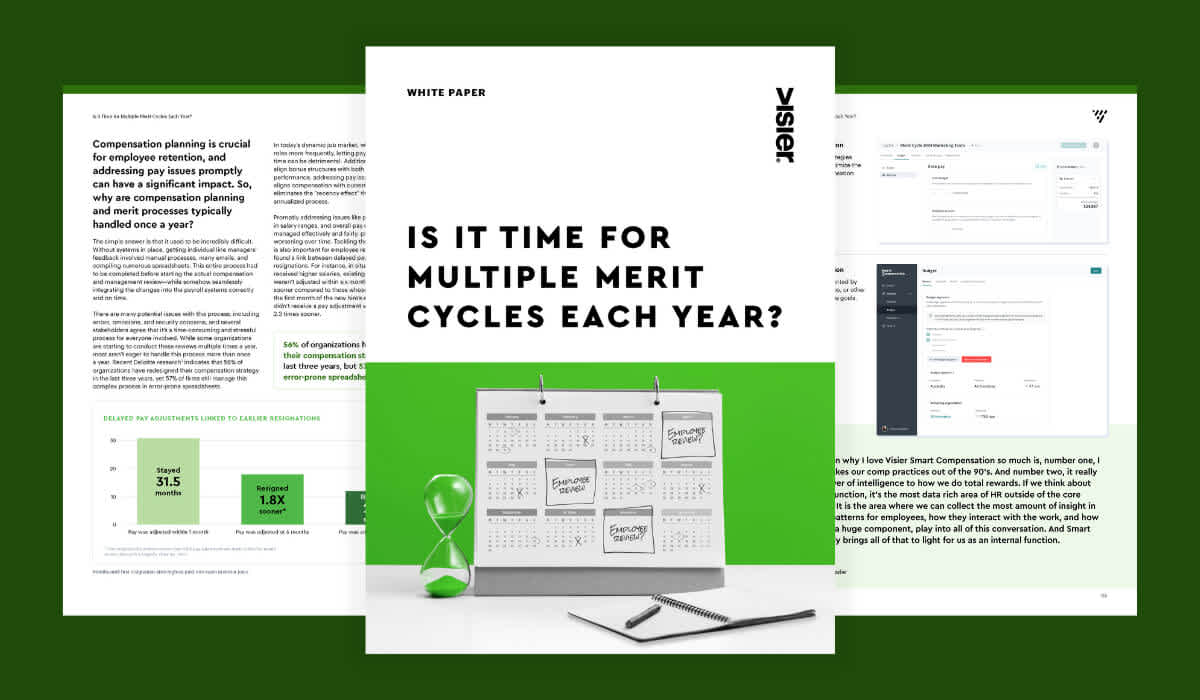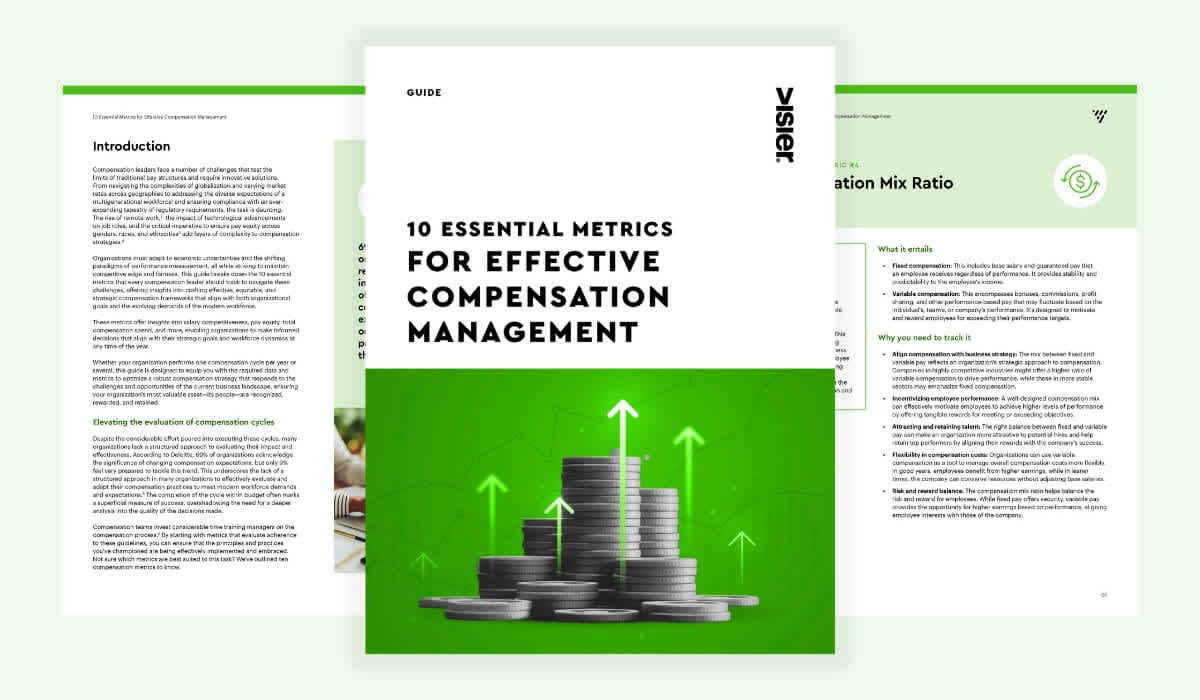How People Analytics and Total Rewards Drive Pay Equity
Discover how to use people analytics and total rewards strategies to drive pay equity under the new EU Pay Transparency Directive.

Pay inequity has been hotly debated over recent years, bringing it to the very forefront of public discourse. As such, it led to the introduction of the EU Pay Transparency Directive, which officially came into force on June 7, 2023.

As part of the initiative, member states are required to integrate the directive into their nation's laws by June 7th, 2026. The directive mandates that companies with 100 employers or more engage in regulatory reporting on gender pay gaps within their organization.
With the deadline for the first round of mandatory public pay gap reports fast approaching, we chaired a roundtable discussion with people analytics, compensation, and total reward leaders in the Visier community to gauge how companies are preparing for the regulatory reporting requirements. the roundtable attendees were split pretty evenly between the compensation and people analytics leaders, highlighting that a joined-up approach is the best way to solve this.
Here’s what we learned about how people analytics and total rewards are driving equity in this new era of pay transparency and disclosure.
The perfect pair: People analytics and total rewards
The compensation and total rewards side of the pay transparency coin is the aspect that you'd perhaps most closely associate with the EU directive, but it's only half of the equation. People analytics—the process of leveraging workforce pay data and analytics to address pay disparities—also has a huge part to play.
Fact: Data ensures objectivity, and both disciplines rely on it. Compensation examines the specifics of how people are paid, and people analytics leverages data to ensure the overall effectiveness of the people strategy.
This is crucial because effective and objective data-driven strategies go far beyond compliance. Of course, compliance is important for each company in terms of avoiding any potential sanctions, but transparent communication around pay also helps build trust and accountability while fostering a culture of continuous improvement and fairness.

Opportunities presented through pay transparency
A number of roundtable participants spoke of the positive nature of the regulatory reporting requirement on pay gaps. While some might see the exercise as a mere regulatory hoop to jump through, others saw it as an opportunity to differentiate themselves in the marketplace.
Some companies are marketing their willingness to charge ahead and become a beacon of leadership in pay transparency to boost their reputation as an employer. It’s something that allows them to attract and retain the best talent around by showing a commitment to fairness.
It appears that the worry about financial fines for non-compliance with the EU directive pales in comparison to the reputational damage that can result from media attention from being seen to be largely ignoring pay disparities.
Overcoming the pay data and analytics challenges
The roundtable participants were aligned on two fundamental challenges that people analytics and total rewards teams must navigate to effectively identify, explain, and remediate gaps:
Fragmented payroll data
Building and maintaining robust compliance analytics
One challenge is aggregating fragmented payroll data. The EU Pay Transparency Directive demands a comprehensive view of your organization's pay data. However, many companies struggle with fragmented data stored across multiple systems, such as payroll software, HRIS, and spreadsheets. These inconsistencies in data definitions and formats can make it difficult to generate accurate and reliable reports on pay gaps.
The process requires you to ingest data from various sources, clean and standardize it, and create a unified data set for analysis rather than an isolated, siloed project. This will give you a complete picture of your workforce and allow you to drill down into specific demographics and job categories for deeper insights into potential pay gaps.
The other challenge is building robust analytics muscle for continuous compliance. The EU Directive's "always-on" nature requires ongoing monitoring and analysis of pay data. Many organizations lack the internal resources or expertise to build and maintain the necessary analytical capabilities. Additionally, traditional reporting tools can be cumbersome and time-consuming, hindering your ability to proactively identify and address pay disparities.
You will need to empower your team with user-friendly self-service insights into your pay equity metrics so that your team can slice and dice your data by various factors, such as gender, ethnicity, experience level, and job function.
Visier helps with both of these challenges and also offers advanced analytics capabilities that go beyond basic reporting, enabling you to identify potential root causes of pay gaps and develop targeted strategies for closing them.

Tackle pay transparency compliance with people analytics
Like it or not, the EU’s new regulatory reporting requirements are here. The total rewards you offer to employees can greatly affect their happiness and influence how you're perceived as an employer. The changing demographics and regulatory landscape have pushed this from aspirational to imperative.
Regardless of where you are on the pay transparency and equity journey, it's time to streamline your fragmented enterprise pay data and build the analytics muscle required to deliver this programmatically.
The Visier team is here to help you overcome these pay data and people analytics challenges, ensure compliance with the EU Pay Transparency Directive, and create a more equitable and competitive workplace.
Pay transparency insights with people analytics
Learn how Bekaert is leading the way in preparing for the EU Pay Transparency directive, and how they're using people analytics to do it.
In this episode of the Human Truth Podcast, we discuss the rising trend of pay transparency and whether or not more companies will join in.
New requirements around ESG reporting should be firmly within the domain of the HR department. Learn why, and the benefits for organizations.
Optimize your compensation strategy by harnessing the power of tracking key compensation metrics to improve talent acquisition, transparency, and pay equity. Find out the top seven metrics here.



